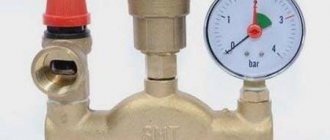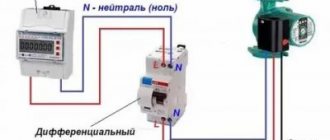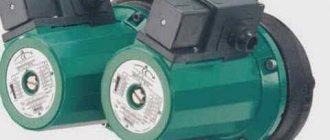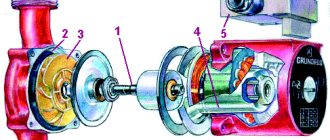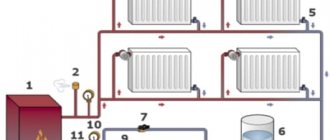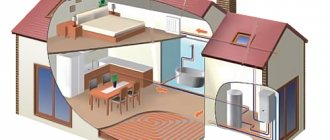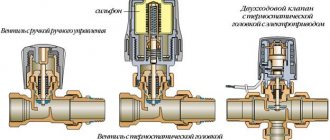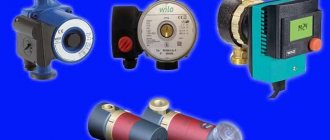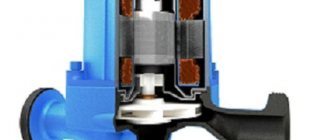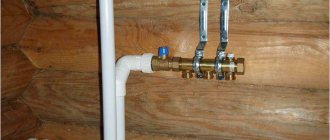Frequent power outages are very dangerous for a closed heating system. After uneven heating, the pressure in the pipes increases, the hot coolant from the boiler moves slowly, which leads to uneven heating of the rooms. An uninterruptible power supply for a heating pump, then a UPS, allows you to get rid of all these problems, because a certain supply of electricity will accumulate in the specified device, which will allow you to maintain the operating condition of the circulation pump during a power outage.
Linear (on-line)
Such intelligent equipment is characterized by double conversion of electricity online. Thanks to these features of the device, voltage surges in the network are leveled out and frequency balance is established. The supply voltage of the heating pump is always stable, 220 volts, which helps to extend the service life of the described device.
Note! This type of UPS quickly turns on the pump during power outages. This is possible through double voltage conversion in the network.
Examples of selecting uninterruptible power supplies for pumps of various capacities
Let's look at a few examples of the correct choice of equipment.
1. It is necessary to provide uninterrupted power to a circulation pump with a power of 50 W. We estimate the value of the starting current, 50 W x 4 = 200 W. Therefore, an uninterruptible power supply is required for a pump with a power of at least 200 W. The optimal solution would be the TEPLOCOM-300 uninterruptible power supply. We decide on the choice of UPS configuration and external battery. UPS TEPLOCOM-300
with a 65 Ah battery is capable of providing autonomous power to a 50 W pump for approximately 12 hours, and a
TEPLOCOM-300
with a 100 Ah battery - for 20 hours.
2. It is necessary to provide uninterrupted power to a circulation pump with a power of 80 W. We estimate the value of the starting current, 80 W x 4 = 320 W. Therefore, an uninterruptible power supply is required for a pump with a power of at least 300 W. The optimal solution would be the TEPLOCOM-300 uninterruptible power supply. We decide on the choice of UPS configuration and external battery. UPS TEPLOCOM-300
with a 65 Ah battery is capable of providing autonomous power to an 80 W pump for approximately 7 hours, and a
TEPLOCOM-300
with a 100 Ah battery - for 12 hours.
If it is necessary to provide a longer reserve, we can suggest using a more powerful uninterruptible power supply TEPLOCOM-1000. This uninterruptible power supply works with two external batteries. TEPLOCOM-1000
UPS with two 100 Ah batteries is capable of providing autonomous power to an 80 W pump for approximately 27 hours, and the
TEPLOCOM-1000
with two 150 Ah batteries - for 40 hours.
3. It is necessary to provide uninterrupted power to circulation pumps with a total power of 160 W. We estimate the value of the starting current, 160 W x 4 = 640 W. Therefore, an uninterruptible power supply is required for a pump with a power of at least 640 W. The optimal solution would be the TEPLOCOM-1000 uninterruptible power supply. We decide on the choice of UPS configuration and external battery. This uninterruptible power supply works with two external batteries. UPS TEPLOCOM-1000
with two 100 Ah batteries is capable of providing autonomous power to pumps with a total power of 160 W for approximately 11 hours, a
TEPLOCOM-1000
UPS with two 150 Ah batteries - for 17 hours, a TEPLOCOM-1000 UPS with two 200 Ah batteries - for 24 hours.
4. It is necessary to provide uninterrupted power supply to circulation pumps with a total power of 240 W. We estimate the value of the starting current, 240 W x 4 = 960 W. Therefore, an uninterruptible power supply is required for a pump with a power of at least 960 W. The optimal solution would be the TEPLOCOM-1000 uninterruptible power supply. We decide on the choice of UPS configuration and external battery. This uninterruptible power supply works with two external batteries. Uninterruptible power supply TEPLOCOM-1000
with two batteries of 150 Ah each is capable of providing autonomous power to pumps with a total power of 240 W for approximately 11 hours, a
TEPLOCOM-1000
with two batteries of 200 Ah each - for 15 hours.
Line interactive
Such devices are manufactured in conjunction with an off-line switch and a voltage regulator that operates in automatic mode. The main advantage of this uninterruptible power supply is the ability to ensure normal operation of the circulation pump when the voltage in the electrical network increases or decreases. The downside of the UPS in question is the certain period of time for switching to the battery during power outages.
Linear-interactive uninterruptible power supply for heating is one of the options for ensuring the safety of the heating system
The efficiency of such devices occupies an intermediate position between simple and cheap off-line UPSs and expensive high-quality devices with on-line double voltage conversion. In practice, line-interactive uninterruptible power supplies are used for continuous operation of desktop computers and monitors, circulation pumps and other devices.
According to the method of obtaining the voltage at the output of the battery, such devices are divided into two main types:
- Voltage generation using a pure sinusoid. Such installations are often used as an alternative to double voltage conversion;
- Obtaining voltage from an approximated sinusoid. Such UPSs are operated in conjunction with a personal computer.
UPS models
Energy PN-1000 is a powerful source of backup power. Thanks to the built-in stabilizer, the device provides the rated output voltage when the mains voltage changes within the range of 120-275 volts. The smooth sine waveform is ideal for powering a reactive inductive load, such as a heating system pump motor. The energy of the PN-1000, together with the Delta DTM 12100L 100A/h battery, provides uninterrupted power for a 150W heating pump for 8 hours. The device has a built-in network noise filter, information display and RS-232 interface.
You can find this and other voltage stabilizers for heating systems from the Energia company on the website of the official representative of the company VoltMarket.ru.
The compact emergency power source Teplokom 222/500 is designed for use in gas heating systems. This simple device with a single-phase relay-type stabilizer ensures operation with a load not exceeding 230 W.
The universal stabilizer Skat ST 1515 provides a voltage of 220 V with network fluctuations from 145 to 260 V and a frequency of 50 Hz ± 1%. If the voltage value exceeds the specified parameters, the load will be turned off automatically.
Let's sum it up
Based on the operational requirements for electric motors of heating system pumps, the UPS must provide the following parameters:
- Voltage shape – smooth sinusoid;
- Power reserve – at least 20%;
- Automatic load shedding;
- Minimum switching time to reserve.
In addition, the device must operate in a certain temperature range and have a device for indicating modes and physical quantities.
With this they read:
Which voltage stabilizer is better: main types and their features
Stabilizers - popular models
How to choose a three-phase voltage stabilizer?
Inverter voltage stabilizer for home: features, advantages and selection criteria
Did you like the article? Share with friends on social networks!
How to choose
When choosing a UPS for a heating system pump, you need to take into account a lot of nuances that will affect the final cost of the device. In this case, the following is taken into account:
- Number of phases. You can buy single-phase and three-phase models on the market, but only the first type is used in everyday life. Three-phase UPSs are designed for industrial needs;
- An important parameter is the power of the device, which is calculated based on the total power of connected consumers. In this case, the starting load of the equipment is taken into account, because it will be greater depending on the operating voltage. This characteristic can be found out from the pump passport; the load value is called “starting current”.
Note! When selecting a UPS for a pump, voltage drops in the electrical network are taken into account. If the increase or decrease in voltage is within 8-9%, then buy an uninterruptible power supply with an operating range of a voltage drop of 10% up or down.
IPB in the heating system
If you neglect this simple rule, then after a sharp jump or drop in voltage, the pump will run on battery power, which will quickly damage the UPS. It is advisable to purchase equipment with several useful functions.
For example, a cold start allows you to turn on the pump even when there is no power in the network. The device must have indicators indicating the battery charge level. A decrease in battery capacity to a critical point must be accompanied by a special sound signal.
Uninterruptible heating system Cyber Power CPS600E
In addition to all the listed nuances, it is necessary to pay special attention to the power of the pump. If you have installed a weak uninterruptible power supply, the built-in battery may not be enough for long-term uninterrupted operation of the system. According to experts, it is best to buy a device with an external battery connection, which will make it possible to select the required capacity of the pump’s backup power source.
Uninterruptible power supply units for heating pump
Externally, the device resembles a large system unit. Often the front panel has a display with a clock and a panel with buttons. Intuitive controls - all basic data is displayed on the screen: input and output voltage, battery charge level, current strength and others.
The essence of its work is to accumulate energy in batteries and then release it when necessary.
Connecting an uninterruptible power supply to the heating system
The UPS consists of:
- uninterruptible power supply unit;
- 12 V battery(s).
The voltage of 220 V is converted to 12 V and supplied to the charger. At the same time, energy feeds the boiler from the network. When the battery(s) are fully charged, the current supply is automatically stopped, i.e. it continues to arrive, but in transit.
If the network is turned off, the UPS begins the reverse conversion - constant from 12 V batteries to alternating 220 V.
Operating principle of an uninterruptible power supply
The automation will automatically turn on the backup power supply, and when the power supply is restored, it will switch to operation from the network. No human intervention is required to charge the batteries. It works silently.
Most often, batteries made using AGM technology or with gel electrolyte are used. Connect them in series. All end bends and jumper cables are included.
Do not place batteries too far from the inverter. This reduces the current readings.
There is one caveat - the UPS takes longer to charge than it discharges. Therefore, an uninterruptible power supply for a circulation pump will not be able to completely replace the power plant for a long time.
The need for a UPS
In addition to the situations already listed (power outages and power surges), a UPS is also useful when the energy source is an air-cooled generator - diesel or gasoline.
The voltage produced from it has a sawtooth output when a pure sine wave is required. A double conversion UPS installed between the boiler and the generator solves the problem.
So, here is a list of requirements for a UPS:
- voltage stabilization;
- possibility of long-term operation without external power supply;
- voltage supply in the form of a smooth sinusoid;
- frequency accuracy;
- smooth and instant transition to batteries;
- reliability.
Heating circulation pumps are economical in terms of fuel costs, which is why they are becoming increasingly popular. Read about how to choose a circulation pump for heating. What is a wet and dry rotor and what parameters should you pay attention to when purchasing? Read about the installation of heated floors and energy costs for heating here.
And here https://microklimat.pro/otopitelnoe-oborudovanie/otopitelnye-pribory/otoplenie-garazha-svoimi-rukami-vodyanoe-gazovoe-otoplenie-teplovye-pushki-i-drugie-tipy-sistem.html you will learn about all kinds of homemade heating systems for the garage. Read and choose your option.
Is it possible to replace the UPS with a computer uninterruptible power supply or use a car battery?
No. Computer UPSs have output voltage in the form of teeth - rectangles. They overheat the circulation pumps.
But car batteries have completely different charge and discharge cycles. They are determined by the thickness of the internal plates.
The result of connecting a computer uninterruptible power supply to a circulation pump
A car battery has thinner electrodes. In addition, you will see that he always “thinks” that he is not fully charged. Battery life will be reduced and resistance will be low. All this will lead to boiling of the electrolyte and will greatly deteriorate the condition of the device.
Car batteries can only be used in well-ventilated areas (the hood of a car is ideal). Explosive hydrogen accumulates in a confined space.
The service life of special batteries for UPS, with proper use, is 12 years. If, contrary to the warnings, you use a car one, it will fail much earlier. Therefore, the savings in this case are questionable.
Varieties
There are two types of UPS for the circulation pump (based on switching time):
- Line-interactive.
- On-line.
Linear interactive:
- The time it takes for such a UPS to switch to battery operation is 4-10ms.
- They use one or two batteries with a capacity from 38 to 100 A/h.
- Lower voltage.
- Stabilizer required.
- They cost less.
Uninterruptible power supply classification
On-Line:
- switching time to battery – 0 s.;
- protects against voltage surges by double conversion;
- can work autonomously longer;
- use at least three batteries with a capacity from 45 to 100 A/h;
- filter functions;
- are more expensive.
Connection diagram
Let's consider a diagram for connecting an uninterruptible power supply with two batteries. In this case, the batteries are connected in parallel, which will increase their total capacity. Let's calculate the operating time and cost of such a system.
Connection diagram of an uninterruptible power supply to the heating system
Note! With an increase in the number of batteries, their total capacity will increase and the operating time of the heating pump and additional devices that are connected to the UPS will increase.
As the power of connected devices increases, their operating time in offline mode will increase. The pump itself, when operating in standard mode, has a power of 50 watts, in which case two powerful batteries will ensure 50 hour operation of the device. If you connect another native consumer to the UPS, for example, a light bulb with a power of 100 watts, then their battery life will decrease to 18 hours. At a load of 500 watts per hour, two new charged batteries will completely lose their charge after 5 hours of operation.
Uninterruptible power supply with batteries
As for costs: an average-priced uninterruptible power supply will cost 17 thousand rubles, plus two batteries for 14 thousand rubles. We will get 31,000. For this money you can buy a gasoline electricity generator, but this requires additional expenses for gasoline and certain skills in working with the installation. Of course, a UPS can be bought cheaper; a gas generator is used here as an alternative option.
Operating principle and design of the UPS
The name itself shows the purpose of the device - to provide uninterrupted power supply from a reserve when the main source is turned off. The first uninterruptible power supplies appeared after the creation of computers and were intended to maintain high-quality power supply and short-term continuation of work after the main power was turned off. The UPS filters the incoming voltage, and if it does not meet the required parameters or disappears, it automatically supplies power to the consumer.
The UPS consists of the following main components:
- power switching system (bypass);
- Charger;
- DC to AC converter;
- governing body;
- battery.
Internal Components
A switch is needed to switch the voltage source. The working element can be a power relay (in cheap models), thyristors, and recently IGBT transistors have begun to be used. The response time ranges from 6–10 ms. The ability to switch a current of a certain power affects the power of the entire device. In interactive circuits, the commutator is also used to switch the terminals of the autotransformer windings.
The charger unit converts the input AC voltage into a rectified voltage of the required value to charge the battery. This device will determine which batteries can be charged.
Carefully! When choosing a battery, it is important to know its charging current; usually it is 1/10 of the capacity; if it exceeds the capabilities of the device, the battery will not charge.
The conversion of the battery's direct current into alternating voltage is carried out by an inverter. It is he who is responsible for the voltage quality and power of the UPS. The battery is the source of energy for such a conversion, and its capacity will determine how long the uninterruptible power supply can provide energy to consumers.
Schematic diagram
Electrical components, buttons, and switches act as the control body. LCD screens can be used for visual control. According to the principle of operation of UPS for heating there are:
- reserve;
- interactive;
- double conversion.
To understand what is their difference, it is worth analyzing each circuit; in the future, this will help solve the question of how to choose a UPS?
Reserve
The simplest circuit uses a simple filter at the input that can delay high-voltage and electromagnetic pulses; it is made in the form of a capacitor (C) or a coil and capacitor (LC). The load is connected directly to the network. If the power quality deteriorates significantly or if it disappears, the supply voltage is supplied from the UPS. Used in simple and cheap models. Often used to power computers, it has a high efficiency of about 99%.
Appearance of a computer UPS
The disadvantage is the complete lack of ability to change the voltage amplitude and frequency of the mains current. The inverter circuit is simplified as much as possible, which leads to distortions in the shape of the sine wave. Instead of a sinusoid, as a rule, there are rectangular signals. They are not dangerous for the computer, since the current is immediately rectified.
Important! Asynchronous motors used in pumps can only operate normally with the correct sine wave; if low-quality energy is supplied, they will function poorly and quickly fail.
For lighting and heating devices, the signal shape does not matter.
Linear interactive
This circuit is more suitable for an uninterruptible power supply for all heating system pumps. The main difference from the previous circuit is the ability to change the input voltage. To do this, a transformer is installed in the input circuit, the primary winding of which has several terminals; it acts as a stabilizer.
At rated voltage, no adjustment is made, and if the balance is disturbed, additional turns are automatically connected or disconnected. This stepwise switching allows the battery to be used less, which significantly extends its life.
Interactive UPS diagram
The inverters used produce rectangular, trapezoidal, step or sinusoidal voltage, it all depends on the complexity of the device. Naturally, this affects the cost.
Inverter
The inverter or double conversion circuit is very different from the previous two. There is no direct connection of the load to the network, but the connection occurs according to the following scheme: the network voltage passes through a surge filter, a rectifier, after which part of the energy, if necessary, goes to charge the battery, and the rest goes to the inverter, is converted into alternating current and goes to the consumer.
Appearance of the inverter UPS
A fully automated system capable of controlling amplitude and frequency, the output signal shape is as close as possible to a sine wave. When the mains power is turned off, the UPS continues to operate from the battery, which has virtually no effect on the output signal.
How to make a UPS with your own hands
The option of assembling an uninterruptible power supply for a heating pump with your own hands is not excluded. This is possible, although it will cause a lot of trouble. First, you need to understand that without specialized knowledge there is nothing to do in this path, wasted money and wasted time. If you have self-confidence, then decide on the assembly method:
- from scratch;
- from separate components.
Assembly from scratch is only possible for experienced engineers; amateurs will face nothing but disappointment here. If you decide to assemble a UPS from separate components, then follow the following diagram.
Diagram of how to make a UPS for a heating pump
By the way, the difference between assembling a UPS for a heating pump with your own hands and buying a serial model at a price will be about 30%.
